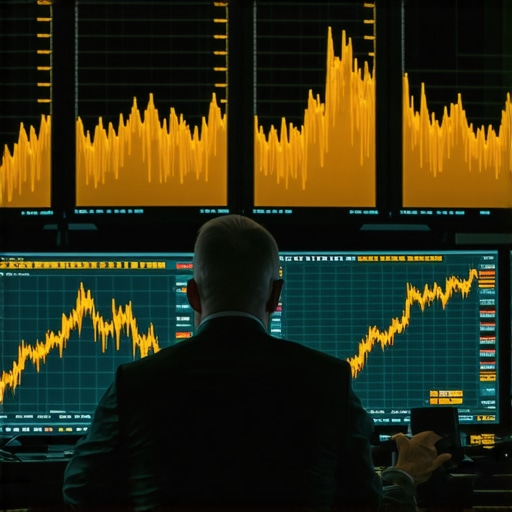Understanding Gold Futures as an Investment Vehicle
Investing in gold futures can be a lucrative strategy for those looking to capitalize on gold’s price movements. As a derivative, gold futures allow investors to speculate on the future price of gold without the need to own physical gold. This means you can leverage your investment, potentially increasing your gains while also managing risk. However, navigating this market requires a clear understanding of several key strategies.
Key Strategies for Successful Gold Futures Investment
To invest effectively in gold futures, consider the following strategies:
1. Stay Informed About Market Trends
One of the most critical aspects of investing in gold futures is staying updated on market trends. Understanding the factors that influence gold prices, such as global economic indicators, geopolitical events, and changes in supply and demand, can significantly enhance your investment decisions. Resources like Understanding Gold Market Trends: Essential Insights can provide valuable analysis.
2. Utilize Technical Analysis
Technical analysis involves studying historical price charts and patterns to predict future movements. By identifying trends, support and resistance levels, and using indicators such as moving averages, investors can make informed decisions about when to enter or exit trades. This approach can be particularly beneficial in the volatile gold futures market.
3. Diversification of Your Portfolio
Diversifying your investments is crucial in managing risk. While gold futures can be a profitable venture, it’s wise to balance your portfolio with other assets. Consider including physical gold, gold stocks, or ETFs in your investment strategy. This can help mitigate risks associated with market fluctuations. For more on this, check out Gold Coins vs. Gold Bars: Which is the Smarter Buy?.
4. Leverage Risk Management Techniques
Effective risk management is essential when trading gold futures. Set clear stop-loss orders to limit potential losses and ensure you’re not over-leveraging your positions. Understanding your risk tolerance and maintaining a disciplined trading approach can help you navigate the inherent volatility of gold futures.
5. Monitor Global Economic Indicators
Gold is often viewed as a safe-haven asset during economic downturns. Monitoring key economic indicators such as inflation rates, interest rates, and currency fluctuations can provide insights into potential price movements. For instance, rising inflation typically boosts gold prices as investors seek protection against eroding purchasing power.
6. Be Aware of Seasonal Trends
Gold prices can exhibit seasonal trends influenced by demand in various sectors. For example, demand for gold tends to rise during certain festivals and wedding seasons in countries like India. Being aware of these seasonal patterns can provide strategic insights into the timing of your trades.
Conclusion
Investing in gold futures can be a rewarding venture when approached with the right strategies. By staying informed, utilizing technical analysis, diversifying your portfolio, managing risk effectively, and monitoring economic indicators, you can enhance your chances of success in this dynamic market. For those interested in exploring more about gold investment strategies, consider reading Best Gold Investment Strategies: Maximize Your Returns.
Understanding the Importance of Gold Futures in a Diversified Portfolio
Incorporating gold futures into your investment strategy can significantly enhance your portfolio’s diversification. Gold is often viewed as a hedge against economic instability, making it a valuable asset during turbulent times. By understanding how gold futures work, you can leverage this knowledge to protect your investments and capitalize on market opportunities. To further explore why gold is essential for hedging against inflation, check out Why Gold is Essential for Hedging Against Inflation.
Exploring Different Types of Gold Investments
Investors have various options when it comes to gold investments. Each type comes with its unique advantages and risks. Besides gold futures, you might consider:
1. Physical Gold
Investing in physical gold, such as coins or bars, allows you to own a tangible asset. This can be particularly appealing during times of financial uncertainty. For a comprehensive guide on physical gold investments, visit A Comprehensive Overview of Gold Demand Trends.
2. Gold ETFs
Gold Exchange-Traded Funds (ETFs) offer a convenient way to invest in gold without the need to manage physical storage. They track the price of gold and can be bought and sold like stocks, making them an accessible option for many investors. If you want to know more about the best choices for 2025, read Exploring Gold ETFs: The Best Choices for 2025.
3. Gold Mutual Funds
Gold mutual funds invest in a diversified portfolio of gold-related assets, including mining companies and physical gold. They offer professional management and can provide exposure to the gold market without the need for direct investment in gold itself. To discover the advantages of gold mutual funds, check out Exploring the Benefits of Gold Mutual Funds in 2025.
Evaluating the Risks Associated with Gold Futures
While gold futures offer exciting opportunities, they also come with inherent risks. Understanding these risks is critical for making informed investment decisions:
1. Market Volatility
The gold market can be highly volatile, with prices influenced by various factors, including geopolitical tensions and changes in monetary policy. Staying abreast of these dynamics can help you navigate this volatility effectively.
2. Leverage Risks
Gold futures are often traded on margin, which means you can control a large position with a relatively small amount of capital. While this can amplify gains, it can also lead to significant losses if the market moves against you. Implementing sound risk management strategies is essential.
3. Timing the Market
Correctly predicting market movements can be challenging. It’s crucial to have a disciplined approach and avoid making impulsive decisions based on short-term price fluctuations. For insights on timing your investments, consider reading How to Assess Gold Trading Conditions in 2025.
Conclusion
Investing in gold futures can be a powerful addition to your investment strategy, offering opportunities for wealth preservation and growth. By understanding the various types of gold investments, evaluating the associated risks, and utilizing effective strategies, you can navigate the gold market with confidence. For a deeper dive into maximizing your gold investment returns, don’t miss Best Gold Investment Strategies: Maximize Your Returns.
Strategies for Successful Gold Futures Trading
To effectively trade gold futures, investors should employ well-thought-out strategies. Understanding market dynamics and having a clear trading plan can enhance your success rates. Here are some key strategies to consider:
1. Technical Analysis
Utilizing technical analysis can provide insights into price movements. By analyzing historical price charts, patterns, and trends, you can identify potential entry and exit points. For traders looking to refine their skills, consider exploring Exploring Effective Gold Trading Techniques for 2025.
2. Fundamental Analysis
Understanding the fundamental factors that drive gold prices is crucial. This includes monitoring economic indicators, geopolitical events, and central bank policies. Having a strong grasp of these elements can help you make informed trading decisions.
3. Risk Management Techniques
Implementing robust risk management strategies is essential when trading gold futures. This includes setting stop-loss orders and defining your risk-reward ratios. By managing your risks effectively, you can protect your capital and sustain your trading activities over the long term.
Benefits of Gold Futures Trading
Gold futures trading offers several advantages that make it an attractive option for investors:
1. Leverage Opportunities
Trading on margin allows investors to control larger positions with a smaller amount of capital. This leverage can amplify potential profits, making gold futures appealing for those looking to maximize their returns.
2. Flexibility in Trading
Gold futures can be traded in various market conditions, whether bullish or bearish. This flexibility allows traders to capitalize on both rising and falling gold prices, enhancing profit potential irrespective of market trends.
3. Diversification Benefits
Incorporating gold futures into your investment strategy can diversify your portfolio. By adding gold to your asset mix, you can reduce overall portfolio risk and enhance long-term performance. If you’re interested in diversifying further, explore Gold Investment Strategies: Diversifying Your Portfolio.
Future Trends in Gold Futures Trading
As the financial landscape evolves, so do the trends in gold futures trading. Here are some emerging trends to watch:
1. Increased Demand During Economic Uncertainty
In times of economic uncertainty, the demand for gold often increases as investors seek safe-haven assets. This trend can drive up gold prices and create opportunities for futures traders.
2. Technology Integration
The rise of technology in trading platforms is making gold futures trading more accessible. With advanced tools and analytics, traders can make more informed decisions and execute trades more efficiently.
3. Sustainability and Ethical Investing
As sustainability becomes a priority for many investors, ethical considerations in gold mining and trading practices are gaining traction. Understanding these dynamics can influence investment choices and strategies in the future.
By staying informed about these trends and continuously refining your trading strategies, you can position yourself for success in the gold futures market. For more insights on maximizing your investment in gold, don’t miss Maximizing Investment in Gold Coins: A Strategic Guide.
Analyzing Market Conditions for Gold Futures Trading
Understanding market conditions is vital for anyone involved in gold futures trading. A range of factors, including global economic indicators and investor sentiment, can impact gold prices significantly. Keeping an eye on these elements can enhance your trading decisions.
1. Global Economic Indicators
Economic indicators such as inflation rates, unemployment figures, and GDP growth can provide insights into gold’s price movements. For instance, rising inflation typically boosts gold prices as investors flock to gold as a hedge against currency devaluation. To delve deeper into how these factors influence gold demand, check out How Global Demand Impacts Gold Prices: An Analysis.
2. Investor Sentiment and Behavior
Investor sentiment can drive gold prices up or down. With the rise of social media and online trading platforms, understanding how market psychology influences trading decisions is essential. Monitoring trends and sentiment analysis can provide a competitive edge.
Key Considerations for Successful Gold Futures Trading
Successfully trading gold futures requires a careful approach and consideration of various factors. Here are some essential elements to keep in mind:
1. Timing Your Trades
Timing is crucial in gold futures trading. Understanding when to enter and exit positions can significantly affect your profitability. Technical analysis tools can help identify optimal trading opportunities based on price movements. For a more comprehensive understanding, explore Analyzing Gold Price Movements: Tips for New Traders.
2. Staying Informed About Geopolitical Events
Geopolitical events can create volatility in the gold market. Events such as elections, trade disputes, and international conflicts often lead to increased demand for gold as a safe haven. Staying informed will enable you to anticipate market reactions and adjust your trading strategies accordingly.
Strategies for Long-Term Success in Gold Futures
For those looking to invest in gold futures for the long haul, implementing effective strategies is paramount. Here are a couple of strategies that can enhance your chances of success:
1. Diversification Across Different Gold Investments
Investing in a mix of gold assets, including futures, ETFs, and physical gold, can help mitigate risks. Diversification allows you to benefit from different aspects of the gold market while reducing exposure to any single investment type. For insights on portfolio diversification, read The Growing Importance of Gold in a Diversified Portfolio.
2. Continuous Learning and Adaptation
The gold market is dynamic, and staying ahead requires continuous learning. Follow market trends, attend webinars, and engage with trading communities to enhance your skills and knowledge. Adapting your strategies to new information and market conditions will help you navigate challenges successfully.
By integrating these insights and strategies into your trading plan, you can improve your potential for success in the gold futures market. For more expert advice on gold investments, consider checking out The Role of Gold in Today’s Economic Landscape.
Frequently Asked Questions About Gold Futures Trading
1. What are gold futures?
Gold futures are contracts to buy or sell a specific amount of gold at a predetermined price on a future date. They are traded on commodity exchanges and are often used by investors to hedge against price fluctuations or speculate on price movements.
2. How do gold futures work?
When you buy a gold futures contract, you agree to purchase gold at a specified price at a future date. If the market price rises above your agreed price, you can sell the contract for a profit. Conversely, if prices fall, you could incur losses.
3. What are the benefits of trading gold futures?
Trading gold futures offers several benefits, including leverage, the ability to go long or short, and the opportunity to hedge against inflation and currency fluctuations. Additionally, gold is often viewed as a safe-haven asset during times of economic uncertainty.
4. What factors affect gold futures prices?
Gold futures prices can be influenced by a variety of factors, including global economic conditions, inflation rates, interest rates, currency strength (especially the U.S. dollar), and geopolitical events. Understanding these factors can help traders make informed decisions.
5. How can I get started with gold futures trading?
To get started with gold futures trading, you should first educate yourself on the market, choose a reputable broker, and develop a trading plan. Consider starting with a demo account to practice trading strategies without risking real money.
6. Is gold futures trading risky?
Yes, trading gold futures carries significant risks, including market volatility and the potential for substantial financial loss. It is essential to understand these risks and employ effective risk management strategies to protect your investments.
7. How do I analyze gold futures prices?
Analyzing gold futures prices involves both technical analysis and fundamental analysis. Technical analysis focuses on price charts and patterns, while fundamental analysis examines economic indicators and news events that may impact gold prices.
8. Can I trade gold futures without a broker?
No, trading gold futures typically requires a brokerage account with a firm that offers access to commodity exchanges. Your broker will facilitate trades and provide tools and resources to help you succeed.
Authority Resources for Gold Futures Trading
When engaging in gold futures trading, it’s crucial to rely on accurate and authoritative sources for information. Here are some trusted websites and literature to enhance your trading knowledge:
- CME Group – Gold Futures Education: A comprehensive resource for understanding gold futures, including market dynamics and trading strategies.
- Investopedia – Gold Futures Definition: An informative article explaining the basics of gold futures and how they work.
- BullionVault – Gold Investing Guide: A detailed guide on investing in gold and strategies for trading gold futures.
- Kitco – Gold Market News: A leading source for news and analysis on the gold market, providing real-time prices and expert insights.
- World Gold Council – Gold Market Reports: Offers extensive research and reports on gold supply and demand, investment trends, and market developments.
Conclusion
Gold futures trading presents a unique opportunity for investors to engage with one of the world’s most valuable commodities. By understanding market conditions, employing effective strategies, and utilizing reliable resources, traders can navigate the complexities of gold futures with confidence. Whether you’re a novice or an experienced trader, continuous learning and adaptation are key to achieving long-term success in the gold futures market. Remember, informed decisions backed by solid research and analysis will enhance your potential for profitability in this ever-evolving landscape.











I found the discussion about leveraging risk management techniques particularly essential for those new to gold futures trading. From my experience, one of the trickiest parts about trading gold futures is balancing the allure of leverage with the potential for significant losses. Early in my trading journey, I learned the hard way how critical it is to implement strict stop-loss orders and remain disciplined rather than chasing quick profits. Additionally, the point about staying updated on global economic indicators resonates deeply. I’ve noticed that markets react swiftly to shifts in inflation data or geopolitical developments, so keeping an eye on these can be a real game-changer. However, I wonder how other traders manage the emotional ups and downs given the volatility inherent in gold futures. Has anyone found particular strategies or mindset practices to maintain composure and avoid impulsive decisions during turbulent market phases? It would be great to hear about practical approaches that help in sustaining long-term success amidst such volatility.
Laurie, I completely relate to the challenge of managing emotions in the volatile gold futures market. From my experience, one of the most effective mindset practices has been maintaining a strict adherence to a predefined trading plan with clear entry and exit criteria. This discipline helps minimize impulsive decisions driven by fear or greed. I also incorporate mindfulness techniques, like short meditation or deep-breathing exercises before making trades, which surprisingly help in calming down during market swings. Additionally, keeping a trading journal to document the rationale behind each trade has been valuable for self-reflection and learning, preventing repeat emotional mistakes. On the topic of staying informed, I find that blending both technical and fundamental analysis offers a more rounded perspective — for example, using moving averages alongside economic reports to confirm trade signals. Also, I think the post’s emphasis on diversification can’t be overstated; incorporating a mix of gold futures, ETFs, and physical gold has helped balance my portfolio’s risk. I’m curious if others have had success with specific risk management strategies like scaling into positions or using trailing stop losses to protect profits? It would be enlightening to hear different approaches to emotional resilience and risk management in this ever-changing market.